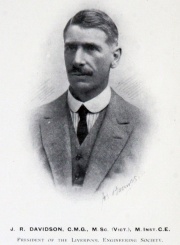Jonathan Roberts Davidson

Colonel Sir Jonathan Roberts Davidson (1874-1961)
1961 Obituary [1]
COLONEL SIR JONATHAN ROBERTS DAVIDSON, C.M.G., M.Sc., who was born on 29 May, 1874, died on 21 June, 1961.
Educated at Beaumaris Grammar School, he studied engineering at University college, Liverpool. He graduated B.Sc. with honours in 1895, and in 1898 was awarded the M.Sc.
From 1895-98 he received his practical training as a pupil under Mr Joseph Parry, M.I.C.E., Chief Engineer to the Liverpool Corporation Waterworks. During his pupilage, among other work, he set out the line and levels for a new tunnel-aqueduct l.25 mile long, from the River Cownwy to Lake Vyrnwy in North Wales, and later, as Assistant Engineer, he supervised the tunnelling work and the laying down of ventilating plant and machinery. On completion of his pupilage he was appointed to the Corporation staff as Resident Engineer on the Rivington works comprising large catchment reservoirs, filter beds, and a 44in. trunk main to Prescot.
From 1902-4 he was Resident Engineer of the Norton-Prescot section of the Vyrnway supply scheme.
In 1905 he became Principal Assistant Engineer for Rivington, Vyrnway, and the Corporation’s new works, and in 1914 he was appointed Chief Engineer, Liverpool Corporation Waterworks.
During World War I he served with great distinction on the Somme and at Ypres, commanding the 1st Battalion, the Liverpool Scottish Regiment for three years, gaining three mentions in dispatches, and being created C.M.G. in 1915. He was released from military duty on petition of the Liverpool Corporation on account of the urgency of large extensions to the Vymwy supply.
On his retirement in 1934 he accepted a 5-year contract as Chief Engineer, Metropolitan Water Board, but the Board retained his services until 1949 to supervise, among other projects, the construction of Staines and Chingford reservoirs, the reconstruction of Hampton Works and the winding up of the contract for Walton reservoir which had been held up by World War II.
Sir Jonathan played a leading role in engineering throughout his life and served on many Government committees. He was a member of the Executive Committee of the British Waterworks Association for several years during which he was Chairman of the Water Regulations Committee. He was also a member of Council of the Institution of Water Engineers.
In 1936 he was elected to the Council of the Institution of Civil Engineers, becoming President in 1948. He was knighted in 1942.
Elected an Associate Member in 1900, he was transferred to the class of Members in 1919.
Sir Jonathan Davidson is survived by his widow and three sons.

